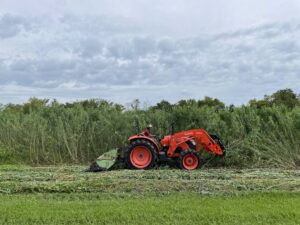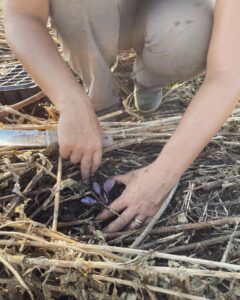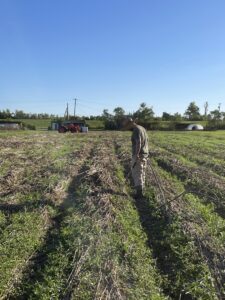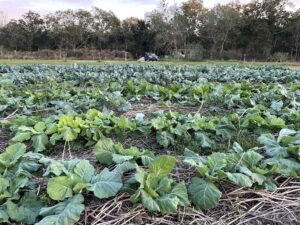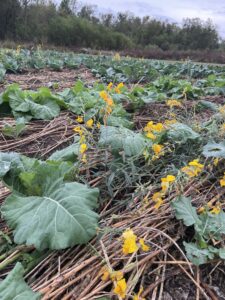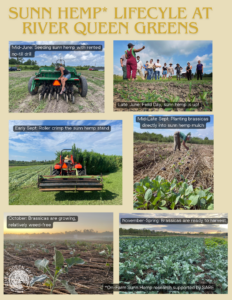Progress report for FS23-351
Project Information
We believe that sunn hemp seeded with a no-till drill for optimal coverage and crimped at the right height has the potential to reduce reliance on tillage and create a growing environment that would enable year-round vegetable production on our farm.
In May of 2022, we started an experiment in one of our fields that had been cover cropped for nine months following Hurricane Ida. We seeded approximately one acre with sunn hemp and let it grow through the summer. In early September 2022, when the sunn hemp was well over 10’ tall, we crimped it with a roller crimper that we’d purchased the previous year. (See photo 1.) This created a mass of material that we then directly planted our fall brassicas into. (See photos 2 and 3.) The crimped sunn hemp acted as an in-place mulch for weed suppression in our long season crops, providing a decent amount of weed suppression through the spring of 2023. Although the initial timing of the crimping and the coverage of the sunn hemp wasn’t ideal (photo 4 shows moderate presence of weeds), this experiment showed promising results for addressing some of the concerns described above. (See photos 5 and 6 for conditions after intensive hand-weeding.)
In mid April of 2023, after being awarded our SARE grant and using funds to purchase seed, we broadcasted sunn hemp on half of a field (about ½ acre) with the intention that the sunn hemp would grow through spring and be roller-crimped in late June/early July in preparation for seeding winter squash directly into the mulch. Because of the timing of the grant award, we were not able to successfully coordinate renting the no-till drill in time for this particular seeding and instead relied on broadcasting this first application of sunn hemp. Spring 2023 turned out to be extremely dry, resulting in poor germination (see photo 7) of the broadcasted sunn hemp and a sparse overall stand. While we did roller-crimp the stand that came up (see photo 8), we quickly determined it was far too grassy to seed winter squash into and have therefore postponed that part of the proposal until this year. We will be seeding another ½ acre on April 3, 2024, this time with a rented no-till drill, with the plan to seed winter squash into the crimped sunn hemp in early July. If the sunn hemp stand is more robust this time around, we anticipate that it will suppress summer weeds enough to allow for winter squash to grow through the summer, thus replacing the need for black plastic or herbicides and providing a viable alternative for sustainable summertime growing in our region.
While our April 2023 seeding of sunn hemp was unsuccessful, our June 2023 seeding, with a no-till drill, was very successful. Despite the ongoing spring and summer drought, the sunn hemp that we seeded with a no-till drill on about 1 acre in June 2023 grew into a beautiful stand all summer (see photo 9). We crimped this stand (see photo 10) in September 2023 and planted several successions of fall brassicas directly into the hemp mulch (see photo 11). The sunn hemp residue kept the field dry through heavy winter rains, provided adequate weed suppression through the winter (see photo 12), and is even providing some cover as we transition into spring planting in March of 2024 (see photo 13).
From an economic standpoint, using sunn hemp as a grown-in-place mulch has proven to be a time and labor-saver in the late summer when there is still high weed pressure and a heavy planting load. While we did need to do some spot weeding of vines that grew alongside the sunn hemp, we collectively only spent 1 half day (5 people, 4 hours so 20 labor hours) weeding the entire 1 acre field between September 2023 and March 2024. We estimate that this is about 25% of the time we spent weeding our broadcasted sunn hemp field from the previous year (depicted in photos 1-6).
Additionally, we still anticipate that the economic impact of summer crops grown directly in sunn hemp will be substantial. If successful, this will increase our crop yield during the slow market period during September and early October. Crops like winter squash, melons, and fall peppers, which we currently don’t grow at all because of the challenges of over-summering in our climate, will enable us to return to market a month earlier than we currently do. It will have a positive impact on the market, which is typically low on products across the board that time of year, and it will mean that we are able to pay our employees with actual cash flow during the summer and early fall months. With a successfully applied sunn hemp crop, we expect these summer edible crops would be low maintenance for an employee to manage during our hottest, wettest months in Louisiana.
In addition to the photos, please also see attached letters of support from our collaborators and other relevant community partners.
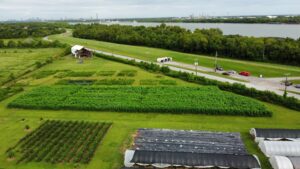
Letter of Support - Angelina Harrison, Crescent City Farmers Market
Letter of Support - Anna Timmerman, LSU Ag Extension Agent
Proposed Strategy:
Use of sunn hemp as weed suppression and technique for reducing tillage to allow marketable summer crop production and no/low tillage field prep year-round.
Methodology:
We intend to introduce regular sunn hemp seeding with a no-till drill into our crop rotation to be roller crimped and used as a mulch for year-round vegetable production. Sunn hemp seeded with a no-till drill would reduce the dependance on tillage, allowing us to seed directly into existing raised beds directly following the termination of previous crops. This system will improve our ability to grow marketable crops during the environmentally challenging summer season. It will also improve and maintain soil health through:
- Regular cover cropping and use of mulching to add nutrients (carbon, nitrogen).
- Weed control through regular cover cropping with rapid growing sunn hemp seeded with no-till drill, and the subsequent presence of sunn hemp residue as mulch post-roller crimping.
- Use of frequent cover cropping to maintain soil structure through repeated plantings directly into mulch without requiring tillage.
To determine the effectiveness of this solution, we would collect data on the following measures:
1.Improvement of nutritional levels in soil.
- Soil sample annually to reveal changes to nutrient levels. Note that Field B has had prior sunn hemp crop.
2.Effectiveness of weed control.
- Keep data on frequency of hand weeding. (Compare to current crop).
- Regular observation and comparison of weed pressure to other fields where sunn hemp has not been applied. This will be accomplished through comparing photos and taking observational notes.
3.Reduction in need for tillage.
- Keep data on frequency of tillage (discing).
- Use drone images to track sunn hemp seasonal growth and measure coverage with no-till drill. Can be compared year-to-year.
4.Reduced amount of time away from market.
- Keep data on volume and viability of new crops that we haven’t grown before including winter squash, melons, fall peppers.
- Compare market return dates to previous years.
- Compare revenue generated in September and October to past years.
By implementing a system of crop rotation with sunn hemp on three separate fields (B, E, and H) through the two year duration of this project, we will be able to observe the four different seasons of a three-year rotation using sunn hemp, edible crops, and other cover crops. By using three different fields totalling approximately 1.5 acres, we will be able to compare soil samples at different stages and maximize the limited window of the project to collect the most data.
Cooperators
Research
We have been and intend to continue using sunn hemp cover crop, seeded with a no-till drill, in our crop rotation to be roller crimped and used as a mulch for year-round vegetable production. Sunn hemp seeded with a no-till drill has proven effective at reducing our dependence on tillage when seeding cover crop, allowing us to seed directly into existing raised beds directly following the termination of previous crops. We are hoping that as we continue to refine this system, we will improve our ability to grow marketable crops during the environmentally challenging summer season. It also has and will continue to improve and maintain soil health through:
- Regular cover cropping and use of mulching to add nutrients (carbon, nitrogen).
- Weed control through regular cover cropping with rapid growing sunn hemp seeded with no-till drill, and the subsequent presence of sunn hemp residue as mulch post-roller crimping.
- Use of frequent cover cropping to maintain soil structure through repeated plantings directly into mulch without requiring tillage.
To determine the effectiveness of this solution, we are collecting data on the following measures:
1.Improvement of nutritional levels in soil.
- Soil sample annually to reveal changes to nutrient levels.
2.Effectiveness of weed control.
- Keep data on frequency of hand weeding. (Compare to current crop).
- Regular observation and comparison of weed pressure to other fields where sunn hemp has not been applied. This will be accomplished through comparing photos and taking observational notes.
3.Reduction in need for tillage.
- Keep data on frequency of tillage (discing).
- Use drone images to track sunn hemp seasonal growth and measure coverage with no-till drill. Can be compared year-to-year.
4.Reduced amount of time away from market.
- Keep data on volume and viability of new crops that we haven’t grown before including winter squash, melons, fall peppers.
- Compare market return dates to previous years.
- Compare revenue generated in September and October to past years.
By implementing a system of crop rotation with sunn hemp on three separate fields (B, E, and H) through the two year duration of this project, we will be able to observe the four different seasons of a three-year rotation using sunn hemp, edible crops, and other cover crops.
1.Improvement of nutritional levels in soil.
- Soil sample annually to reveal changes to nutrient levels. While we are continuing to take annual soil samples (next results should arrive in April 2024), we are also realizing that sunn hemp will not be the only input as we compare year to year results. We have been experiencing widespread crop loss in some of our growing spaces, and are therefore planning to apply a targeted fertilizer blend to all of our fields prior to seeding cover crop in the spring and summer of 2024. We therefore expect that the soil sample results (beyond this first year to year comparison) will not reveal anything specific related to the sunn hemp, though anecdotally we can see that the physical composition of the soil is much more workable after a cycle of sunn hemp. This could also be a general cover crop result, and we expect that the year-to-year soil analysis would reveal any specific sunn hemp improvement, but we are going to have to forego that comparison after this year in order to address some bigger picture fertility issues on our farm.
2.Effectiveness of weed control.
- Keep data on frequency of hand weeding. (Compare to current crop). As described above in the abstract, we did need to do some spot weeding of vines that grew alongside the sunn hemp that collectively added up to about 1 half day (5 people, 4 hours so 20 labor hours) weeding the entire 1 acre field between September 2023 and March 2024. We estimate that this is about 25% of the time we spent weeding our broadcasted sunn hemp field from the previous year.
- Regular observation and comparison of weed pressure to other fields where sunn hemp has not been applied. This will be accomplished through comparing photos and taking observational notes. In addition to the comparison described above, we are also noticing a significant difference in spring (aka now) weed pressure between this year’s sunn hemp field and last year’s sunn hemp field. (The section of last year’s sunn hemp field shown in photo 15 grew some leftover okra and peppers over the summer and then was tarped over the winter.) While this year’s field, 6 months after crimping the sunn hemp, does contain some weed pressure in spots (see photo 14), we are noticing a specific decrease in the grass pressure compared to the field that had sunn hemp 18 months ago and then subsequently grew crops and was tarped for the recent winter. (see photo 15)
3.Reduction in need for tillage.
- Keep data on frequency of tillage (discing). We have not needed to disc or otherwise till the soil in the fields where we have grown sunn hemp using a no-till drill.
- Use drone images to track sunn hemp seasonal growth and measure coverage with no-till drill. Can be compared year-to-year. See photos 16-19 showing sunn hemp growth from our (unsuccessful) April 2023 planting (photos 16 and 17) and our (successful) June 2023 planting (photos 18-19). We will be hiring our drone operator in the next month to show the current residual coverage of the sunn hemp from June 2023, as well as show the state of the field as we prepare to seed sunn hemp in April 2024 (these are the same field this year).
4.Reduced amount of time away from market.
- Keep data on volume and viability of new crops that we haven’t grown before including winter squash, melons, fall peppers.
- Compare market return dates to previous years.
- Compare revenue generated in September and October to past years.
This data is not available this year as we failed to adequately grow enough sunn hemp in the spring of 2023 to create a viable growing environment for crops grown through the summer. We hope to successfully grow a sunn hemp stand that can be crimped in June/July of this year for summer crop growth.
Overall, we continue to be excited and encouraged by the results we have seen thus far with sunn hemp. While we have had a few stands with underwhelming germination and/or growth, we think that those resulted in large part due to broadcasting (failed April 2023 stand) vs using a no-till drill, and also seeding too late in the season (October 2023 stand for the winter crimping experiment). Our biggest field that has so far gotten the sunn hemp followed by a crimp – our fall brassica field – worked out beautifully even after being seeded in the middle of a scorching drought during the hottest time of year. The sunn hemp still germinated beautifully and grew to be about 10’ tall in 3 months. This observation alone demonstrated for us the importance of a no-till drill in our climate. Not only is it difficult to drive on bare soil for so much of the year here due to moisture, but when it is dry it tends to be VERY dry, and hot, thus greatly hindering germination during our heaviest cover cropping season.
After only 1 year of grant research, and after using the no-till drill only 2 times with a 3rd scheduled for April 3, 2024, we are already lobbying our local Soil and Water Conservation District to facilitate the purchase and/or transportation of one for our more immediate region. As of now, transporting the no-till drill is by far the biggest cost associated with this sunn-hemp system. Currently the implement is rentable from a regional ag supply shop, but the shop is 99 miles away and the only hauler willing to pick it up charges $2/mile, so $800 per there and back trip. We would use the no-till drill for so many additional applications and even smaller cover crop windows around our farm if only it were closer and/or more affordable to use. For now, we will continue to plan around its availability, our weather windows, and our consolidated cover crop seeding dates, as even the minimal use has proven to be worth the coordinated effort and expense to get it for even 1 day.
Educational & Outreach Activities
Participation Summary:
To date we have hosted one on-farm Field Day in June 2023 and were panelists in a conference session on cover crops. We will be hosting our second Field Day on April 3, 2024. At our on-farm Field Day last June, in collaboration with Sprout NOLA, we hosted a group of 15 growers and local ag agents and showed them the areas on our farm that had just been seeded with sunn hemp. We also crimped a stand of sunn hemp that had been seeded two months prior. We discussed our plans for this project and talked about how crimped sunn hemp could be implemented on different scales.
In January, 2024, a group of Louisiana-based sustainable ag organizations hosted a farmer climate convening for 200 participants and invited us to present on cover crops in one of the sessions during the conference. We introduced our experiment with sunn hemp (handout included here) to a group of growers, and discussed the importance of cover crop in general in our production practices.
In April 2024 we will be hosting a second Field Day at the farm, which is scheduled to take place on the day we rent our no-till drill so that participants can see how we use it to seed sunn hemp. They’ll also see the remnants of the field where we crimped sunn hemp in the fall of 2023 and are currently replanting with summer crops. The same day, we’ll also be hosting a cohort of staffers from US Senator Bill Cassidy’s office, and will be discussing the importance of local, sustainable agriculture to our region. We hope that they will participate in the Field Day to learn about some of the innovative practices farms in our region are implementing in the face of a changing climate.
In our original proposal we had planned to host a winter Field Day this past December or January, which didn’t happen due to poor germination of our fall cover crop planting during the extreme drought. We plan to do a Fall Field Day in September or early October this year when we’re crimping and planting into our summer sunn hemp stand. Our last Field Day will be in March 2025 when we will have completed two years of this research and can present a more complete report for our audience. At that time we will also write an article with our findings and submit to Growing For Market and LSU Ag Center’s 5 Acres or Fewer Farm News.
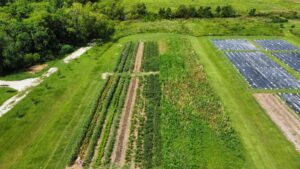
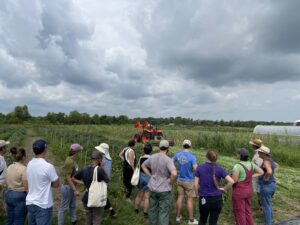
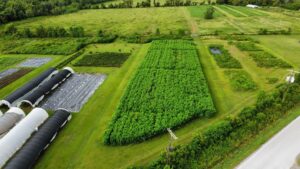
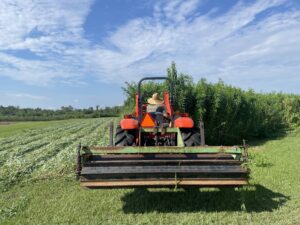

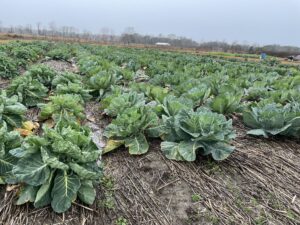
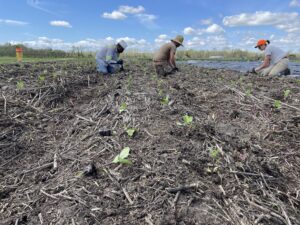
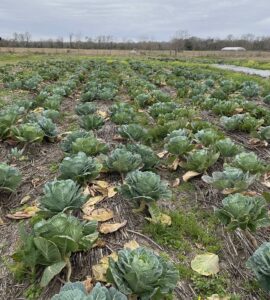
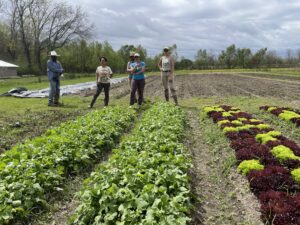
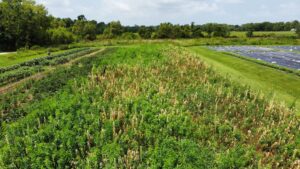
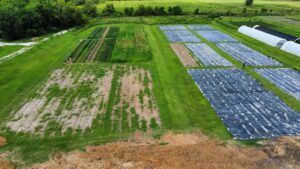 photo 18
photo 18